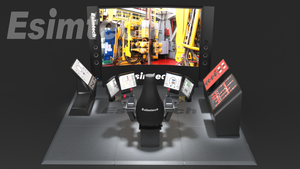Why the Drilling Simulators are Important in the Oil and Gas Industry
Body
Drilling simulators play a vital role in the oil and gas industry by providing safe, cost-effective, and efficient training opportunities while simultaneously improving skills and reducing environmental impact.

Safety: Drilling simulation training systems offer a controlled and secure environment for trainees to learn and practice drilling skills. They can replicate various drilling scenarios, including emergencies and equipment breakdowns, enabling trainees to respond swiftly and effectively in real-life situations.
Cost-Effective Training: Utilizing drilling simulators is a low-cost method of training and preparing drillers and other personnel. It eliminates the expenses associated with using actual drilling equipment and reduces equipment downtime, which is often necessary for training purposes.
Skill Enhancement: Drilling simulation systems enable trainees to enhance their skills and knowledge. The simulators can simulate challenging and complex drilling situations, helping trainees improve their problem-solving and decision-making abilities.
Environmental Benefits: Drilling and well control simulators can help minimize the environmental impact of drilling and well operations. By simulating scenarios beforehand, drilling operators can anticipate and avoid potential hazards and reduce environmental effects.
Operational Efficiency: Drilling simulators have the potential to increase the overall efficiency of drilling operations. Operators can reduce downtime, enhance drilling accuracy and efficiency, and increase production by using simulators to train workers and identify potential issues before they arise.
Main Components of Drilling Simulators
Hardware: This includes the physical components of the simulator, such as the computer, monitors, and input devices like joysticks and control panels. The hardware is designed to closely resemble a real drilling rig to provide a realistic experience.
Software: The drilling simulator's software is the core component responsible for recreating the drilling operation. It simulates drill bit movement, drill string rotation, and the behavior of the rock formations being drilled. It can also simulate various drilling scenarios, including equipment failures and emergencies.
Visualization System: The visualization system presents learners with a three-dimensional image of the drilling environment, including the drill rig, drill string, borehole, and surrounding geological formations. Realism in the visualization system is crucial to provide an accurate portrayal of a real drilling scenario.
Control System: The control system allows trainees to interact with the drilling simulator in a manner similar to how they would operate a real drilling rig. This includes controlling the movement of the drill string, monitoring drilling parameters, and responding to crises and equipment malfunctions.
Data Management System: The data management system collects and interprets drilling simulator data, such as drilling performance, equipment performance, and trainee performance. This information can be used to enhance training programs and optimize drilling operations.

Common Applications of Drilling Simulators
Training: Drilling simulation training systems are used to train drillers, wellsite supervisors, and engineers in the safe and effective execution of drilling operations. Trainees can practice and refine their abilities in a realistic drilling environment before going to the field.
Equipment Testing: Drilling simulators are ideal for testing new drilling equipment, such as drill bits, drill strings, and downhole instruments. Operators can evaluate equipment performance and identify any flaws before field utilization by simulating drilling activities.
Well Planning: Drilling and well control simulators aid in improving drilling parameters and planning well trajectories. Operators can simulate the drilling process to find the best path for the wellbore and determine the most effective drilling parameters, reducing drilling time and costs.
Safety and Emergency Response: Drilling simulation systems prepare personnel for emergencies and equipment failures. Operators can practice emergency response protocols and develop the skills needed to respond swiftly and effectively to various scenarios.
Performance Monitoring: Drilling simulators are valuable for monitoring drilling performance and identifying areas for improvement. Operators can optimize drilling operations, boost efficiency, and minimize costs by collecting data on drilling parameters and equipment performance.
In conclusion, drilling simulators are critical tools that enhance safety, efficiency, performance, and cost-effectiveness in the oil and gas industry.











Comments